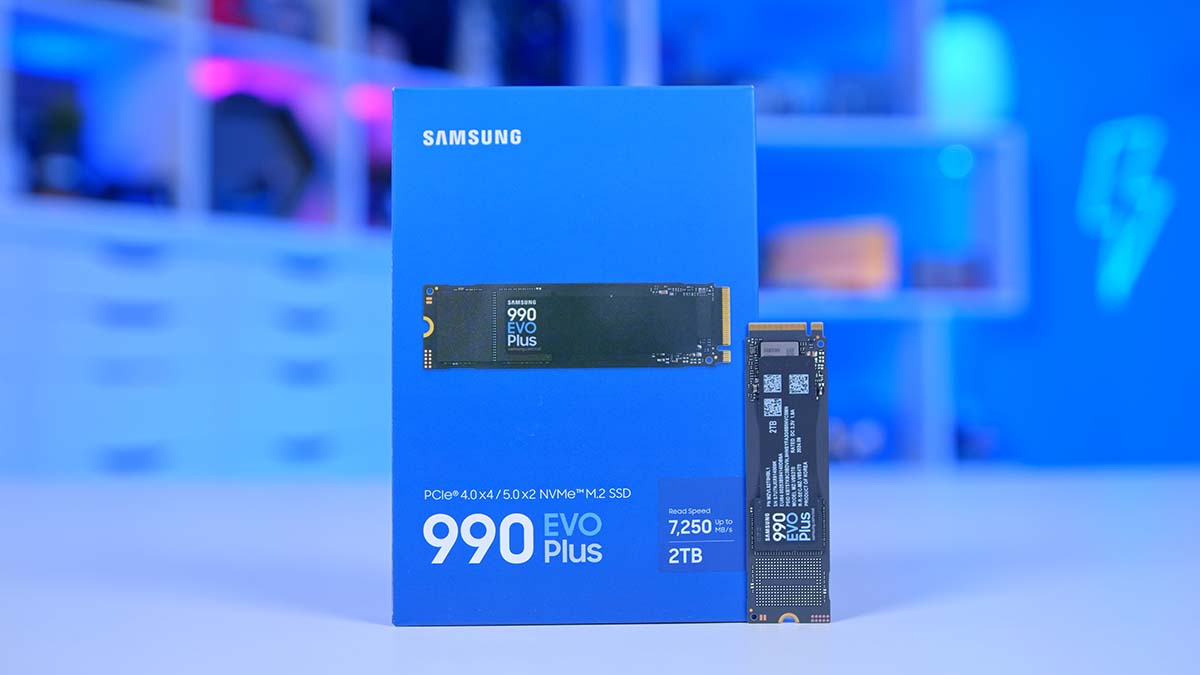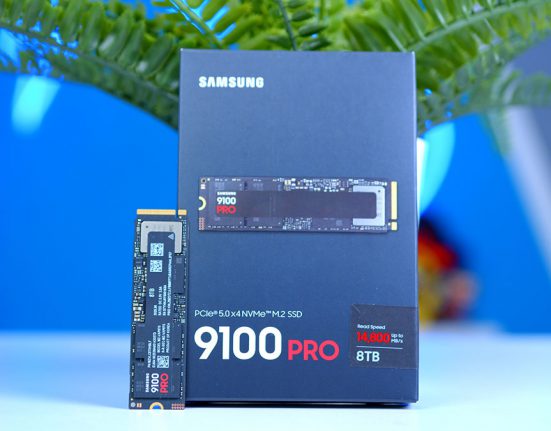The Samsung 990 EVO Plus Gen5 NVMe SSD has joined a highly competitive market where storage options are primarily geared towards enthusiast and workstation PC builds. This particular M.2 SSD is an interesting choice among the existing Gen5 options, as Samsung has designed the drive to curb thermals using fewer PCI-E lanes. However, a smaller number of lanes results in limited bandwidth, which may weaken the value of the 990 EVO Plus. But we’ve tested this drive to determine where its performance lies compared to the rest of the market.
While the initial batch of Gen5 SSDs was plagued with temperature issues, 2024 has seen a significant shift, with manufacturers solving Gen5 SSD thermal problems by improving the controller. Because of this, dropping the number of PCI-E lanes isn’t necessary, and this ultimately may hinder the value of the 990 EVO Plus due to weaker speeds. However, we’ll leave the speculation for now and see how the benchmarks fare later.
As always, with our SSD reviews, we’ll examine the specs, design, thermals, and performance of the Samsung 990 EVO Plus in depth to determine its value.
Buy the Samsung 990 EVO Plus on:
Specification
Looking at the specs, the Samsung 990 EVO Plus is a Gen5 x2 M.2 SSD, not to be confused with the majority of other PCI-E 5.0 NVMe drives, which use four lanes. The reason why this is so important is that it reduces the available bandwidth. Every time we’re introduced to a new PCI-E generation, the speeds double. So 7.5GB/s (Gen4 speeds) increased to around 15GB/s (Gen5 speeds). By halving the amount of lanes used, the 990 EVO Plus is essentially a Gen5 drive with Gen4 speeds.
This explains why the sequential reads and writes are so low compared to a drive like the Seagate Firecuda 540 or the Corsair MP700 Pro. This isn’t to say the speeds are bad. Gen4 drives are the go-to option for most PC builders. However, the 990 EVO Plus speeds will ultimately impact its value when we consider pricing.

Performance aside, the 990 EVO Plus comes in three different capacities: 1TB, 2TB, and 4TB, so there are plenty of options for those who need more space. The endurance ratings are pretty standard and similar to those of other NVMe SSDs we’ve reviewed this year. The 1TB variant offers a 600TBW (Terabytes Written) rating, which doubles to 1200TBW with the 2TB version and 2400TBW with the 4TB capacity.
Samsung offers a five-year warranty, which is always a solid value add. This drive also uses the standard 2280 form factor, which allows it to fit into a range of modern motherboards with no issues.
| Specification | Samsung 990 EVO Plus |
|---|---|
| PCI-E Generation | Gen5 |
| Capacity | 1TB 2TB 4TB |
| Sequential Read Speed | 1TB: 7150MB/s 2TB, 4TB: 7250MB/s |
| Sequential Write Speed | 6300MB/s |
| Warranty | 5 years |
| Endurance | 1TB: 600TBW 2TB: 1200TBW 4TB: 2400TBW |
| Form Factor | M.2 2280 |
Regarding pricing, the 990 EVO Plus, in the 2TB version, can be picked up for around $149.99, the variant we’re examining in this review. The price of this drive isn’t incredibly far from being acceptable. Still, much like the original 990 EVO, it will struggle to compete with existing Gen4 drives due to lower pricing.
Samsung 990 EVO Plus Design
Like other non-heatsink NVMe SSDs, the Samsung 990 EVO Plus is pretty barebones in design. Manufacturers generally won’t prioritise looks on drives without a heatsink, hence this particular option’s rather lacklustre style.
As stated in the specs, the 990 EVO Plus uses a 2280 form factor supported by most modern motherboards. For this reason, it’ll have no problems slotting into a Z890 or X870(E) motherboard, primarily because many of these boards use tool-less slots.

The drive features a small label covering the flash chips. Because the label covers the chips’ large surface area, it helps transfer and dissipate heat efficiently. This is common across modern NVMe storage solutions, but it leaves me wanting some RGB or something to add some extra flair. Even a passive heatsink that doesn’t feature any fans would be preferable.
Samsung recommends placing the 990 EVO Plus underneath a motherboard heatsink to ensure it doesn’t throttle. While the reduction of PCI-E lanes has been made to curb temperatures, if your motherboard has a heatsink, we recommend using it where applicable.
An Explanation of PCI-E Lanes
PCI Express (or PCI-E) is the interface that graphics cards and SSDs use to communicate and provide data for the CPU. PCI-E exists because it offers high-speed bandwidth, which is ideal for data transmission. The amount of bandwidth each slot has is referred to as lanes. These are the physical links between your GPU/SSD and CPU.

Imagining cars on a road is the best way to explain these lanes. The more lanes, the more cars that can travel on the road. The vehicles in this analogy represent data, so the more lanes available for these ‘cars’, the more data that can travel to and from the CPU.
As a general rule of thumb, NVMe SSDs use four lanes, while graphics cards will utilise 16. Graphics cards need more lanes because GPUs have more data to process quickly. This is worth knowing because the Samsung 990 EVO Plus is unique compared to most NVMe drives, as it only uses two lanes instead of the typical four. This ultimately affects speeds, placing the 990 EVO Plus much closer to Gen4 drives in terms of performance despite using the Gen5 PCI-E interface.

Thermals
To gauge the Samsung 990 EVO Plus’ thermals, we fired up CrystalDiskMark and HWMonitor. CrystalDiskMark puts a synthetic load on a drive of your choice and loads files of a specific size to test the read and write capabilities. While CrystalDiskMark runs, HWMonitor shows temperatures in real-time, indicating how the 990 EVO Plus will cope during a sustained workload.

During this benchmark, the highest temperature from the 990 EVO Plus was 65°C. On average, this drive held firmly at 60°C with a low of 55°C. I’d argue that the thermals here are very solid. Samsung’s attempt to lower temperatures by alleviating fewer PCI-E lanes certainly helps, and even under a 100% sustained workload, this drive never reached any level of danger.
Performance
We used CrystalDiskMark to benchmark the Samsung 990 EVO Plus’ read and write performance. This application provides consistent results and indicates how the 990 EVO Plus will handle games and general usage.
During our testing, the 990 EVO Plus slightly underperformed on the reads. We saw an average of 7071MB/s, which is within the 10% margin that we give for errors. Samsung advertises read performance up to 7250MB/s, so I’d argue that the performance here is pretty close.

However, the write speeds were notably weaker compared to the advertised speeds. CrystalDiskMark reported an average write speed of 5688MB/s, which is below the margin of error we typically offer. This is disappointing, as the 990 EVO Plus is already in a difficult position due to its pricing and positioning as a Gen5 SSD.
Additionally, when we compare the 990 EVO Plus to other Gen5 drives, it is one of the weakest options regarding read and write performance. There is a massive gap in performance between the 990 EVO Plus and ADATA Legend, with the latter reaching nearly 10000MB/s read speeds.
Conclusion
Samsung 990 EVO Plus
Product Name: 990 EVO Plus
Brand: Samsung
-
Design
-
Thermals
-
Performance
-
Value For Money
Summary
The Samsung 990 EVO Plus is a Gen4 drive using the PCI-E Gen5 interface. There isn’t much to say about this drive that’s particularly positive. The main point to note is that the reduction in PCI-E lanes curbs thermals, resulting in solid temperatures across the board. However, this puts the 990 EVO Plus in a precarious position compared to other SSDs. This is because the Samsung 990 EVO is a relatively expensive Gen5 SSD with Gen4 performance.
Nothing on offer from this drive makes it stand out. Its speeds are acceptable but not better than some of the other top-performing drives. There’s no heatsink or fancy RGB. It’s just a fairly standard NVMe M.2 SSD. So, as soon as we compare it to a drive like the Lexar NM790, the Western Digital SN850X, or TeamGroup’s MP44 range, all alternatives are inherently better options. They also don’t require prospective buyers to have the latest motherboards with Gen5 support, which come with a hefty tax as X870 and Z890 are reasonably new. To summarise, the Samsung 990 EVO Plus offers decent thermals, but beyond this, it’s a more expensive Gen5 drive lacking the matching performance that comes with PCI-E 5.0 bandwidth.
Pros
✅ Good thermals
✅ 5-year warranty
✅ Multiple capacities
Cons
❌ Too expensive
❌ Uses two PCI-E lanes
❌ No heatsink



![FI_[DM82] TT MineCUBE Build](https://geekawhat.com/wp-content/uploads/2025/12/FI_DM82-TT-MineCUBE-Build-551x431.jpg)

![FI_[DM78] Corsair Air 5400 + 5090 Gaming PC Build](https://geekawhat.com/wp-content/uploads/2025/11/FI_DM78-Corsair-Air-5400-5090-Gaming-PC-Build-551x431.jpg)


![FI_ [DP040] main image](https://geekawhat.com/wp-content/uploads/2025/08/FI_-DP040-Gallery-2-551x431.jpg)